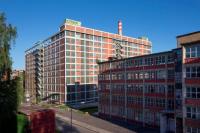
Public buildings
41. Town hall
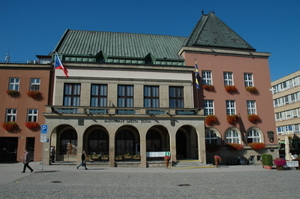 Zlín, náměstí Míru 12
Zlín, náměstí Míru 12
architect: František Lydie Gahura
finished in: 1924
The design for the Zlín town hall was made by Gahura as a part of his diploma thesis and it was selected by the committee of experts in a competition and it is one of the architect´s first realisations. The construction was carried out by the company František Malota & Jan Krajča. Gahura viewed the new town hall as a symbol of the town and based on that he unfolded its material configuration. The implementation of the corner tower is not without interest as it evokes the town gate to the town symbol. Even though Tomas Bata was not happy with the result of Gahura´s work, years later the town hall building appears to be a timeless work. The statue of the blacksmith on the north façade of the town hall in Bartošova street (used to be Kovářská) is also a piece of work by F. L. Gahura. The building has been listed in the List of immovable cultural monuments of the Czech Republic since 2001.
42. Market Hall
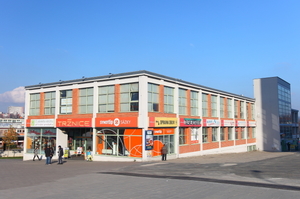 Zlín, náměstí Práce
Zlín, náměstí Práce
architect: Firma A. Jambor
finished in: 1927
In 1927 the first department store was built – nowadays it is the market place – with the wing of kiosks that were demolished later on. That was the first time when the reinforced concrete skeleton used for factory buildings was used for public buildings.
43. Department Store
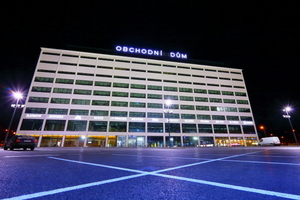 Zlín, náměstí Práce
Zlín, náměstí Práce
Architect: František Lydie Gahura
Finished in: 1931
The shopping centre in Zlín was one of the first buildings built on the newly forming square – Práce sq. When placed the architect respected not only the line of the train aiming from the factory to the brickyard but also the configuration of the terrain. The rear technical facilities were added on in 1934 by Vladimír Karfík. The gradation was also interesting as it was lowering by the height of the line of the windows when moving upwards. This very effective feature architecture wise that optically dematerializes the building has changed with time. The important artistic feature completing the facade was the numerous advertising signs. The whole architectural conception of the building was destroyed by the modifications carried out in the 1970´s
44. Grand cinema
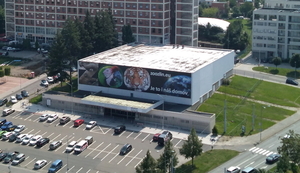 Zlín, náměstí Práce
Zlín, náměstí Práce
Architect: František Lydie Gahura
Finished in: 1932
One of the domains of the Práce sq. is the large cinema built in 1932. Originally it was built as provisory and it was meant to be moved to the level of the Communal house. That is why the typical reinforced concrete skeleton was not used but it was the then remarkable steel construction by Ing.arch. Vtelenský that was used for the span of 33 meters and sheathing with cement bonded particle board as the filling material. The cinema with the viewing gallery for 2 270 persons was the biggest in pre-war Czechoslovakia as well as probably being the biggest in central Europe. The current capacity of the cinema is 1 010 persons. The building has been listed in the List of immovable cultural monuments of the Czech Republic since 2001.
45. Community House (hotel Zlín)
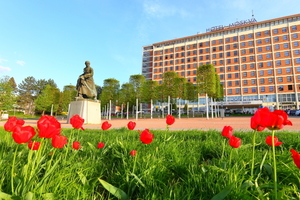 Zlín, náměstí Práce
Zlín, náměstí Práce
Architect: Miroslav Lorenc a Vladimír Karfík
Finished in: 1933
The construction of the building was started based on the project of Miroslav Lorenc by finishing the skeleton of the standard module of 6, 15 x 6, 15 meters. Due to the disagreements of the architects with the company Bata the work was halted. Before the building was finished, architects Gahura and Karfík were invited to put into realization two of the sample rooms including the furnishings and facilities. Tomas Bata surprisingly chose Karfik´s luxurious proposal rather than Gahura´s Spartan like version (with communal hygiene facilities for the rooms). Based on Karfik´s project the building was then finished. The architectural concept of the facade is constructivist with the application of vertical columns of the skeleton and regular alternation of rectangular horizontally segmented windows of the American type with the in-between window joints of rye brickwork. Due to many unsuitable reconstructions (mainly the interior and building on the terrace) the building has lost its original charm.
46. Tomáš Baťa Memorial
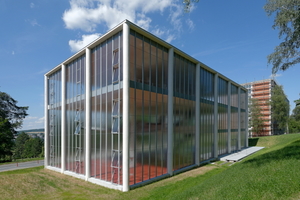 Zlín, náměstí T. G. Masaryka
Zlín, náměstí T. G. Masaryka
Architect: František Lydie Gahura
Finished in: 1933
The monument of Tomas Bata is the most impressive architectural work of F. L. Gahura, it is a modern paraphrase of the constructions of high gothic style period: the supporting system and colourful stained glass and the reinforced concrete skeleton and glass. The building process started in 1933 and the monument was open with ceremony on the day of the first anniversary of Tomas Bata death that is on 12th July 1933. Based on the proposals by F. L. Gahura the monument was meant to be an entrance gate to a complex of four buildings of the learning institute. Between 1936 to1939 only the Learning Institute I. and II. were built. In 1954 the monument was rebuilt (academic architect J. Staša) and turned into the House of Arts later to be used as an art gallery and philharmonic orchestra in Zlín. Since 2011 it is the newly built Cultural and University centre that is the residence of the philharmonic orchestra in Zlín and the building number 14 of the former Bata company area that has been the residence of the gallery since 2012. The monument has returned to its original look after extensive reconstruction and is now serving its true purpose as commemoration of T. Bata. For more information pleas visit the website www.pamatnikbata.eu. The building has been listed in the List of immovable cultural monuments of the Czech Republic since 1958.
47. Baťa Dormitories
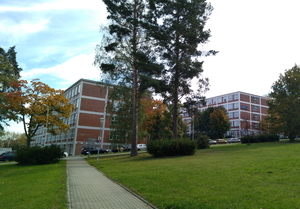 Zlín, náměstí T. G. Masaryka
Zlín, náměstí T. G. Masaryka
Architect: František Lydie Gahura
Finished in: 1930–1937
The first dormitory was built right next to the factory as early as in 1925 and then demolished in 1965. In 1927 the development of the whole area providing communal accommodation was started. The finished urbanistic complex of two rows of free standing boarding school buildings including learning institutes was conformed to the terrain, it had a favourable connection to the factory and up till now it is one of the most characteristic complexes of Zlín. This park complex is the work of architect F. L. Gahura and is quite unique both in size and esthetical value. Construction wise it was the classical solution of reinforced concrete skeleton in the ground module of 6,15 x 6,15meters that was used with the outside fillings by crevice bricks. Nowadays the boarding schools are partially reconstructed and serve as shops, restaurants, offices and only partially for accommodation.
48. Educational Institutes
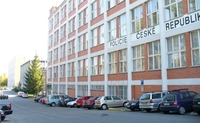 Zlín, náměstí T. G. Masaryka
Zlín, náměstí T. G. Masaryka
architect: František Lydie Gahura
Finished in: I. Learning institute (nowadays Gymnázium and language school), 1938 – II. Learning institute (nowadays Policie ČR)
The educational institutes were a distinctive experiment to create a new education centre and research and development institutions that would be equipped with practical learning appliances, libraries and art collections. Both of the buildings are with its ascetic appearance and strict proportional segmentation connected with the Monument of Tomas Bata that was drafted as the entrance pavilion into a larger studying complex that was only partially completed. Both buildings have been listed in the List of immovable cultural monuments of the Czech Republic since 1997.
49. Commercial and Community House in Díly (Small Theatre)
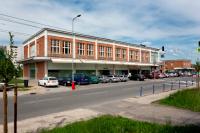 Zlín, Díly, Štefánikova
Zlín, Díly, Štefánikova
Architect: Vladimír Karfík
Finished in: 1937
The shopping centre and a communal house Díly is a dominant buildingof the complex of five buildings that together with the four dormitories create one of the urbanistic complexes that determine the character of the town. The location in the centre of the district Díly and at the same time between the two main street of Bata´ s Zlín is exceptionally successful urbanistic wise. Inside the building there is a screen (today used for theatrical purposes), in the parterre adjoining Štefánikova street there are the shops. The building is one of the few completed examples of constructivist architecture in which we can find the characteristic features of poeticism. Vladimír Karfík managed to draw nearer to the poetry of Devětsil of the 1920´s by the use of the nautical balcony, ramp and symmetric composition. The building still stays connected with the atmosphere of Bata´s Zlín due to the use of the conceded skeleton in the module of the factory buildings and rye based brickwork (originally reduced to the windowsills – there is only a part of the north face of the building that has been preserved in this way). Between the years 2000–2006 the building was successfully reconstructed and an underground extension was built. The original functional use of the building was kept. The building has been listed in the List of immovable cultural monuments of the Czech Republic since 2000.
50. Tomas Bata hospital – historic part
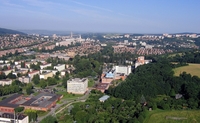 Zlín, Havlíčkovo nábřeží
Zlín, Havlíčkovo nábřeží
Architect: František Lydie Gahura
Finished in: 1927–1938
The co- Architect of the whole hospital premises was its director doctor MUDr. Bohuslav Albert.
The development of the hospital area was one of the first extensive tasks of the building department of the Bata Company. Starting with the vertical orientation towards one building it was due to Gahura´s incentive that the horizontal organization of the functioning and division of the hospital premises into seventeen buildings surrounded by greenery was put into action. The location for the whole premises was selected further away from the factory on the border of the cadastral area of the municipality Příluky on the right bank of the river Dřevnice. Apart from the entrance building and individual pavilions it also had two villas for doctors and a farm building that became part of the premises. The entrance building consisted of examination rooms and operating theatres, administration and nursing personnel. The bedrooms for the patients were located in the standard ground floor pavilions. The main part of the hospital was built at low cost during the first nine months and equipped based on the latest medical findings. The surrounding greenery and impressive pavilion solution also had an effect on the mental health of the patients.
51. Tomášov
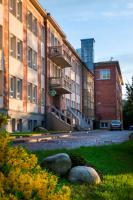 Zlín, Nad Ovčírnou
Zlín, Nad Ovčírnou
Architect: Vladimír Karfík
Finished in: 1938
Tomášov as a building was a part of Bata´s educational system. The building was built based on the module of 6, 15 x 6, 15 meters that is typical for Zlín. Tomášov was connected with Bata´s School of work. Out of the schools gruduates the fifty best students were selected and they were called Tomášovci and were prepared for the top positions of the modern economy around the world. They were copying the elite English and American universities Harrow and Rugby and were nuturing the future salesmen. After the nationalization of the company in 1945 the building of Tomášov became a part of the Svit Company. In the building number 31 what used to be the casualty ward became the internal ward, surgery and later on gynaecology and later neurology and Tomášov became the internal ward. Nowadays the building that was newly reconstructed in 2009 is used by the clinic for reproductive medicine and gynecology.
52. Film studio and laboratories
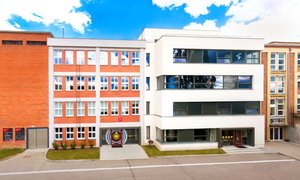 Zlín, Kudlov
Zlín, Kudlov
Architect: Vladimír Karfík
Finished in: 1935–1940
The original small film atelier in Kudlov designed to make advertising films gradually expanded into a studio that significantly participated in the production of short films and film tricks. Also significant experimental films were shot here. The ateliers have been expanded by modern and high-powered film laboratories.
In these days there are private companies, Creative Hill College and Small Cinema (Malé kino), special exhibiton for children and adults - Filmový uzel Zlín and in the building 32 you can visit exhibition Kabinet filmové historie about the history of movie in Zlín.
53. Forest cemetery
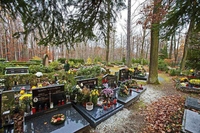 Zlín, Kudlov, Filmová
Zlín, Kudlov, Filmová
Architect: MUDr. Rudolf Gerbec – author of the idea, concept and principles of the cemetery,
Finished in: 1931
The architect aimed to preserve the high quality natural environment. Also the character of all the artistic features – mainly the gravestones that were not meant to be ostentatious, large or out of eye-catching materials – was subjected to the idea. It was only the main cemetery path that was built. The groups of graves were approachable only by small forest paths. The first buried person was the son of doctor MUDr. Gerbec, the others then were the founder of Bata´s Company Tomas Bata (14. 7. 1932) and his pilot Jindřich Brouček.
Opening hours: 1. 11. – 30. 4. 8.00 a.m. – 6.00 p.m.; 1. 5. – 31. 10. 7.00 a.m. – 8.00 p.m.
54. Winter Spa
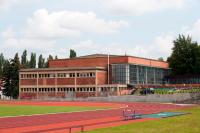 Zlín, Hradská
Zlín, Hradská
Architect: Vladimír Karfík, Josef Holeček, Ladislav Ambrožek
Finished in: 1950
The architectural concept of the building corresponds with other Zlín constructions of the 1940´s -1950´s and it is a very successful example of the classicizing concept of a construction with organic concept of the disposition also in connection to the natural environment. The interior shows in several places a significant influence of the nautical concept of Hans Scharoun (the entrance hall), adequate to the function of the building. The perception of the main area of the swimming pool is undermined by the elimination of the corrugated suspended ceiling. The softly shaped staircase outside the south facing facade was also removed to make way for the development of an outside swimming pool. This change has expanded naturally the original concept. The area has been listed in the List of immovable cultural monuments of the Czech Republic since 2001.
55. Baťa Company Administrative Building No. 21
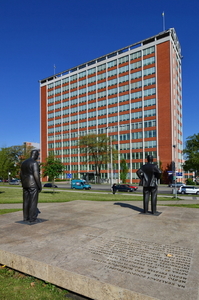 Zlín, třída Tomáše Bati 21
Zlín, třída Tomáše Bati 21
Architect: Vladimír Karfík
Finished in: 1939
One of the masterpieces of the modern Czechoslovak constructivist architecture which was built between the two wars is the administration building of the Bata company. This sixteen-storey and seventy-seven and half meter high building was the highest building in Czechoslovakia before the war. It was situated in the traditional row of factory buildings directly influencing Práce square as it closes up its northern part and hence it becomes a typical dominant characteristic of the modern conception of the town. From the disposition point of view, it is a three corridor building, conceived on the same module platform (6, 15 x 6, 15 meters) like the production buildings. The whole storey with its 80 x 20 meters is one open-plan office mostly without any partitions, where about two hundred people worked. The working area stayed clean because the vertical communication (staircase with lifts) as well as the hygiene facilities and air-conditioning rooms were separated outside this space. The supporting structure is made out of reinforced concrete, the external envelope consists of dual steel windows and brick lining with Slavík tiles. A real technical delicacy is the elevator-office of the director of the company which is 6 x 6 meters, air-conditioned and has a sink. In November 1944 Zlín was bombed but Bata´s skyscraper evaded distruction by a miracle. In 2004 the building was renovated and now it sserves as the residence of the Financial Institution and Regional office of Zlín region. The mobile office in the elevator is fully functional and it serves for tourist sightseeing tours (it is always necessary to book in advance at the Museum of Southeast Moravia or 14|15 BATA INSTITUTE). On the terrace there is a café, the opening hours of the café and the terrace are alike. Karfík´s masterpiece is an immovable cultural monument of the functionalistic era nowadays. The object has been listed in the List of immovable cultural monuments of the Czech Republic since 1958.
56. Buildings number 14 and 15
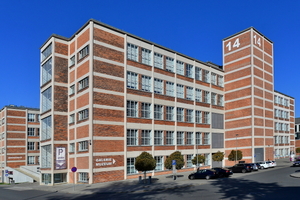 Zlín, Vavrečkova 7040
Zlín, Vavrečkova 7040
Architect: Jiří Voženílek
Finished in: 1946–1949
During the first post-war phase it was necessary to primarily replenish and substitute demolished production buildings and warehouses. The production buildings number 14 and 15 designed for shoe confection and rubber were built along with the central warehouses. During this period of renewal and reconstruction, the principles and knowledge that accompanied the production up till then were used and extended by a new conception of the organization of the production process in the whole factory. The new features of the post-war built buildings for shoe production were good facilities (cloakrooms in-between the floors), wider span, higher light height (4 meters), air-conditioning and lights. For the constructions steel shuttering and typical building envelopes with dual windows were made. It was a development continuation of Bata´s storey houses. The characteristic three corridors of the five storey buildings were kept; the module was changed. Due to procedural and dispositional reasons the traditional module of 6, 15 x 6, 15 meters was abandoned and the peripheral parts were widened (7, 85 x 6, 15 x 7, 85 meters). In the peripheral parts with suspended false ceilings were situated also the air-conditioning engine rooms as well as the hygiene facilities.
Since 2013 cultural organizations have been located in buildings 14 and 15 – a gallery, museum and library.
57. Building number 34
Zlín, Vavrečkova 5657
Architect: Vladimír Kubečka
Finished in: 1949–1955
The project and realization of the central shoe warehouse was the first Czechoslovak attempt to use real modern storage technology with minimal mechanization of the inner transport and carriage. The process of modernization consisted of three phases. The warehouse was located between the premises of the production of leather and rubber shoes. The ten storey colossus with the measurements of 78 x 72 meters with module platform of 6 x 6 meters has the building envelopes made of joint filling brickwork and window areas. On the first floor there was a handling area for dispatching carriage and car deliveries. On the second floor there was an expedition warehouse with a large assortment of products. Expedition was carried out using mobile carriages on an oval track.vertical transport was solved by cargo elevators in the corners of the building. The fire escape staircases are situated in the middle of the building on all four sides of the facade. An interesting point is that on the roof there was meant to be a heliport that would provide a connection between the factory and the airport in Holešov.
58. Evangelical church
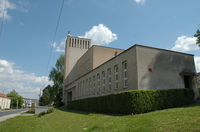 Zlín, Štefánikova 3018
Zlín, Štefánikova 3018
Architect: Vladimír Karfík
Finished in: 1937
The architecture of the evangelical church was handled abstemiously and simply. The style of the temple is connected with the rationality and austerity of Bata´s architecture. Karfík used a lattice system here. The church is built on the composition of three simple cubes – material units: church, quire room and belfry. The main nave of the church was built vertically in the slope with the altar connects to the low material entrance room with an entrance space and facilities. The belfry dominates the building.
59. Chapel of saint Wenceslas (Kaple svatého Václava)
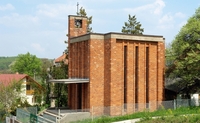 Zlín, Kudlov
Zlín, Kudlov
Architect: František Lydie Gahura
Finished in: 1927
The chapel is found in the slope by the main street in Kudlov. The well-known architect František Lydie Gahura was influenced by the Dutch movement De Stijl when producing the architectural proposal of this new sacred building. The material for the building was donated by Tomas Bata.
60. Monastery Regina
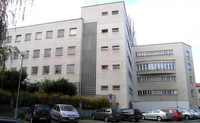 Zlín, Divadelní 3242
Zlín, Divadelní 3242
Architect: Miroslav Lorenc
Finished in: 1938
The architect Miroslav Lorenc designed the project of the monastery that is Klášter kongregace milosrdných sester III. řádu sv. Františka in Opava that now serves as an orphanage. This purist monstrance was established on the land known as Farská louka in the heart of the town centre.
